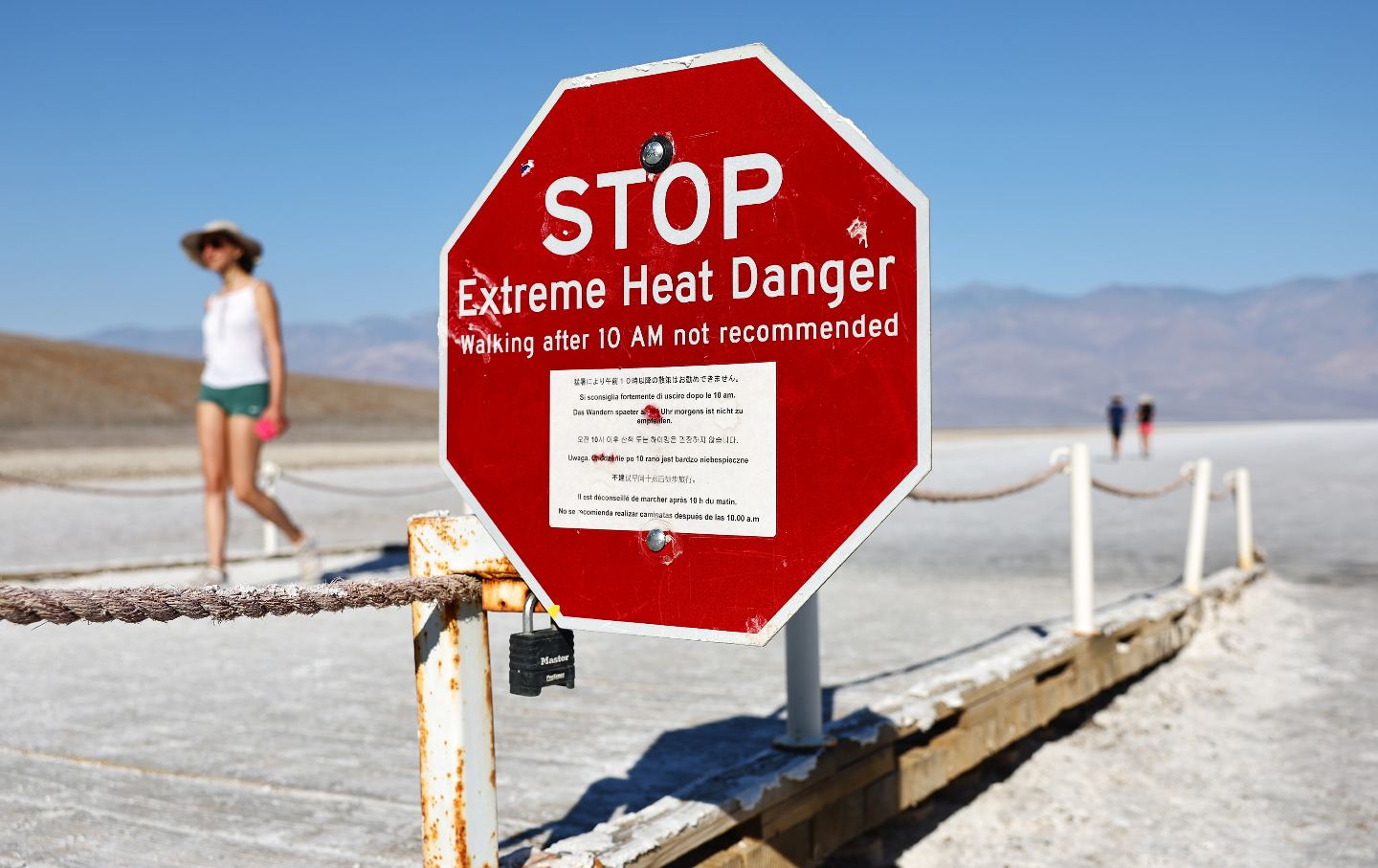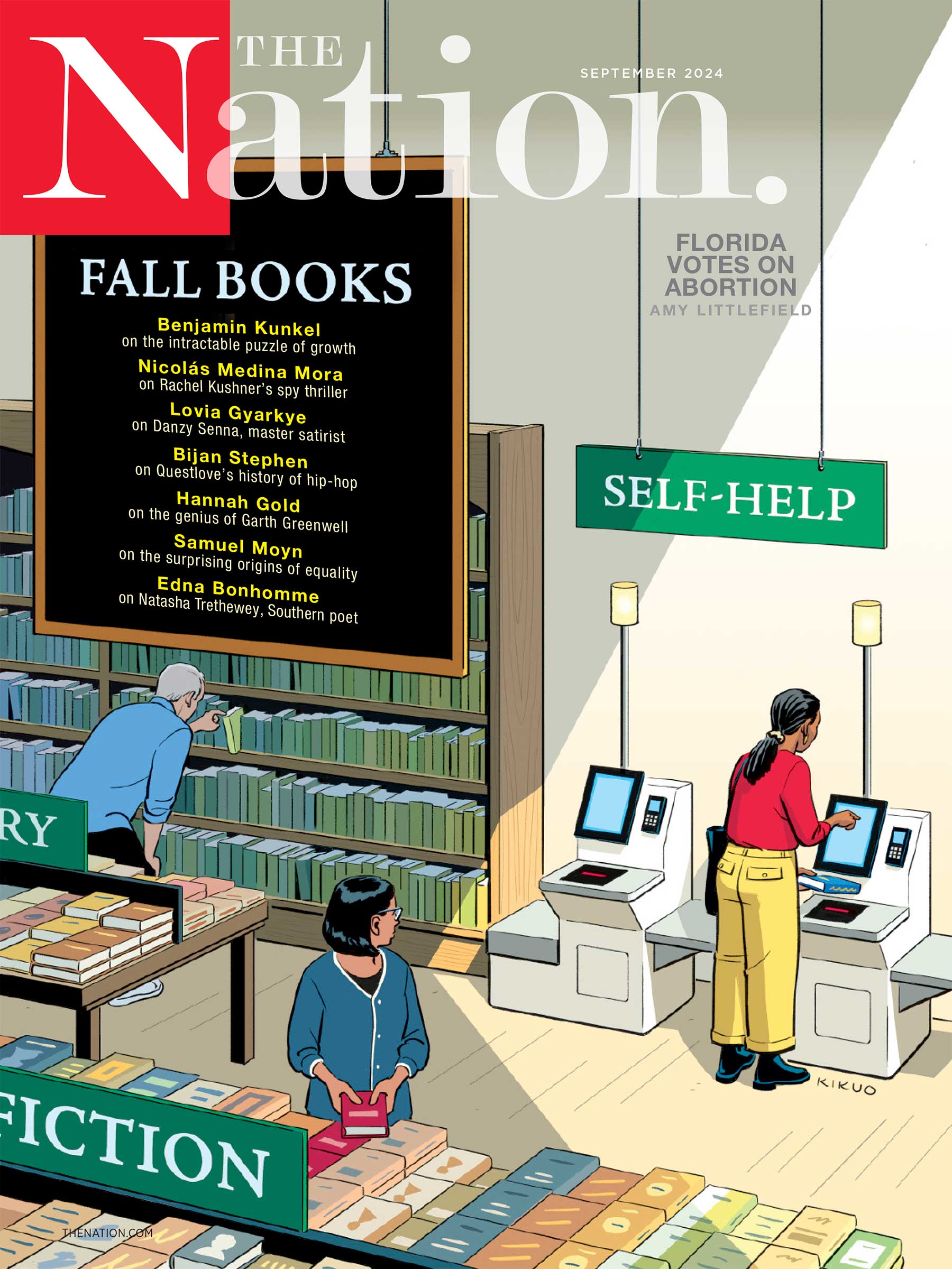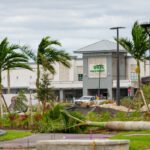
[ad_1]
Environment
/
StudentNation
/
August 26, 2024
Hotter temperatures can increase aggressive behaviors, making violence more likely during the accelerating climate crisis.

Visitors walk near a “Stop Extreme Heat Danger” sign in Badwater Basin salt flats.
(Mario Tama / Getty)
On July 8, about 140 million Americans—more than one-third of the country—were living under a national heat advisory. In what is on track to become another summer of unprecedented heat, heat-related deaths and illnesses are rising. Yet these direct harms are far from the only risks of smoldering summer days. Research shows that as temperatures soar, so does the potential for violence.
Hotter temperatures can increase aggressive intentions and behaviors, making violence more likely as global temperatures continue to rise. A study using data from 100 US cities shows that hotter-than-normal days correlate with a higher risk of shootings—accounting for nearly 8,000 of the total shootings examined. Researchers also found that even moderately hot temperatures were associated with higher risk of gun attacks. Another study linked significant daily mean temperature increases in US cities over a decade-long period with a 4.5 percent increase in sex offenses in the week following such temperatures.
As many US cities experienced their warmest June on record, the US surgeon general declared gun violence a public health crisis–prompted by a string of early summer mass shootings. The accelerating climate crisis is inherently tied to communities’ safety. To protect Americans across the country, our policymakers must invest in a zero-carbon future and a holistic approach to public safety that addresses the root causes of violence and harm.
The heat-violence connection has taken place in a world one degree Celsius warmer than pre-industrial levels, and a 2023 UN report based on analysis of current global policies projected seeing nearly three degrees of warming this century without aggressive climate action.
The hotter days ahead will unfold against a backdrop of more frequent and intense extreme weather events, limited food, and a threatened clean water supply. The consequent decreased access to basic resources such as shelter and food and necessities for survival, which has already forcibly displaced 7.7 million people, only increases the likelihood of conflict.
The United States currently lags behind on both climate action and community safety. The country is rated overall insufficient by the Climate Action Tracker and has higher rates of gun violence and deaths from firearms than many other countries. Only immediate policy change can prevent these gaps from becoming irreversible.
Current Issue

Climate and community safety advocates understand that our work is intersectional. And while everyone is ultimately affected, low-income and historically marginalized communities that are most impacted by climate change are also those most vulnerable to violence. Geography greatly shapes access to safety; communities impacted by a legacy of disinvestment and racial segregation have seen the biggest increase in crime. These communities also disproportionately lack access to public green space and infrastructure—which provide an important barrier against extreme heat—in large part a lasting effect of decades’ worth of racist housing policies. Simultaneously, they’re often subject to disproportionate harms by the criminal-legal system, including racially biased policing and high levels of incarceration.
Meaningful solutions respond to the root causes, not just the symptoms, of climate breakdown and violence. Broader policies to rapidly phase out a fossil fuel economy and stop climate pollution at its source, as well as hold big polluters accountable, are essential. More locally, policymakers can unlock the benefits of bolstering green infrastructure. Establishing more public urban green spaces has been shown to help cool urban communities, as has utilizing rooftops and walls for greenery. Moreover, a growing body of evidence suggests that targeted investments in the local built environment—including streetlights, parks, trees, treatment facilities, revitalized vacant lots, community-based nonprofits, and public art—can increase street safety.
At the federal level, countless organizations are advancing policies that would invest deeply in evidence-based solutions to the root causes of violence, alongside further programs such as community violence intervention and civilian crisis response that transform how we prevent and respond to crises. The People’s Response Act, for example, would create flexible grants for community organizations and local governments to implement programs like street outreach, violence prevention, safe passage to school programs, youth mentorship, harm reduction-based mental health services, as well as built design changes like more parks and streetlights—importantly with community input. It would also create a new Division on Community Safety at the Department of Health and Human Services to further coordinate research, funding, and interagency work on multidisciplinary community safety approaches.
The presence of robust, multidisciplinary institutions to implement and oversee these investments at the local and state levels is fundamental to their success. Chicago’s Community Safety Coordination Center, which recognizes place-based investments in neighborhood spaces as a crucial component of public safety, provides a useful model for establishing local bodies to coordinate multidisciplinary community safety work—a step toward the Departments of Community Safety that we ultimately need. Phoenix, among the nation’s hottest major cities, offers another promising approach as the first city to provide public funding for a designated expert to lead an Office of Extreme Heat Response and Mitigation.
With the upcoming presidential election, we have a unique opportunity to call for increased investment in community well-being and our collective futures. Policymakers must understand that our progress on climate and addressing violence are inextricably linked—and act accordingly.
Can we count on you?
In the coming election, the fate of our democracy and fundamental civil rights are on the ballot. The conservative architects of Project 2025 are scheming to institutionalize Donald Trump’s authoritarian vision across all levels of government if he should win.
We’ve already seen events that fill us with both dread and cautious optimism—throughout it all, The Nation has been a bulwark against misinformation and an advocate for bold, principled perspectives. Our dedicated writers have sat down with Kamala Harris and Bernie Sanders for interviews, unpacked the shallow right-wing populist appeals of J.D. Vance, and debated the pathway for a Democratic victory in November.
Stories like these and the one you just read are vital at this critical juncture in our country’s history. Now more than ever, we need clear-eyed and deeply reported independent journalism to make sense of the headlines and sort fact from fiction. Donate today and join our 160-year legacy of speaking truth to power and uplifting the voices of grassroots advocates.
Throughout 2024 and what is likely the defining election of our lifetimes, we need your support to continue publishing the insightful journalism you rely on.
Thank you,
The Editors of The Nation
Ilana Cohen
Ilana Cohen is a student at NYU Law and a former leader of the Fossil Fuel Divest Harvard campaign. She is a cofounder of the Campus Climate Network organization, a 2022 Brower Youth Award winner, and originally from Brooklyn, New York.
Thea Sebastian
Thea Sebastian is the founding executive director of the Futures Institute, a nonprofit policy advocacy organization focused on advancing community safety and youth opportunity. She is also the former policy director at Civil Rights Corps and previously worked stints in local government, at the White House Domestic Policy Council, and as a special education teacher in the South Bronx.
[ad_2]
Asides
Recent Posts
- A Nutritionist’s Top 18 Inexpensive High-Protein Meals on a Budget
- A few Additions to Greta’s Teen Bedroom
- Zelenskyy appeals to allies to keep up aid as Germany pledges new weapons package
- You Ask, We Answer! Gwen Stefani Wore a Pink and Black Tweed Emilio Pucci Set to the Jennifer Hudson Show
- The Impact on Hotels in Florida
Popular Tag





